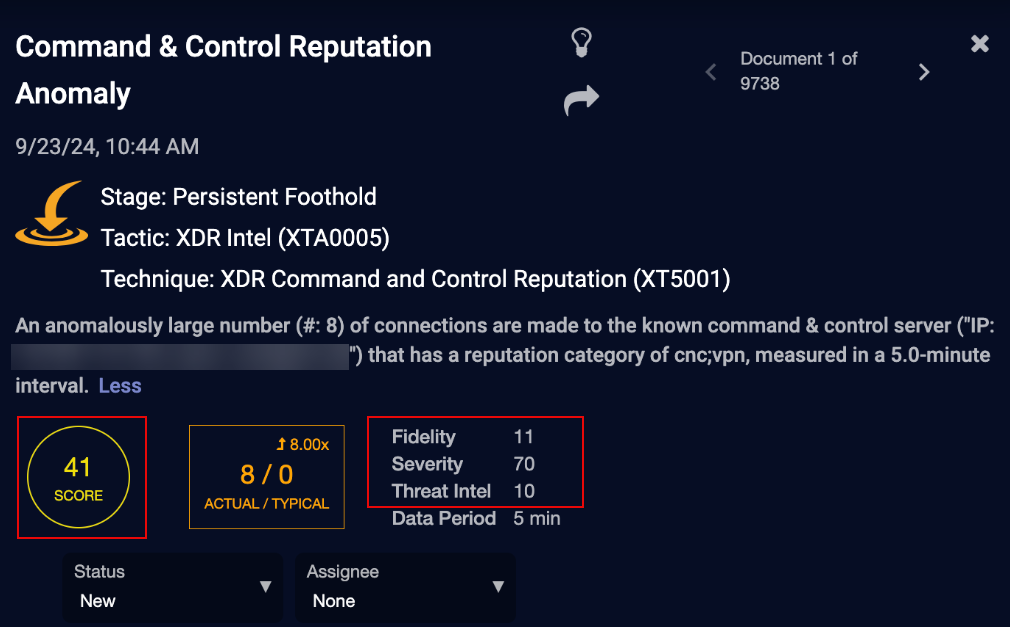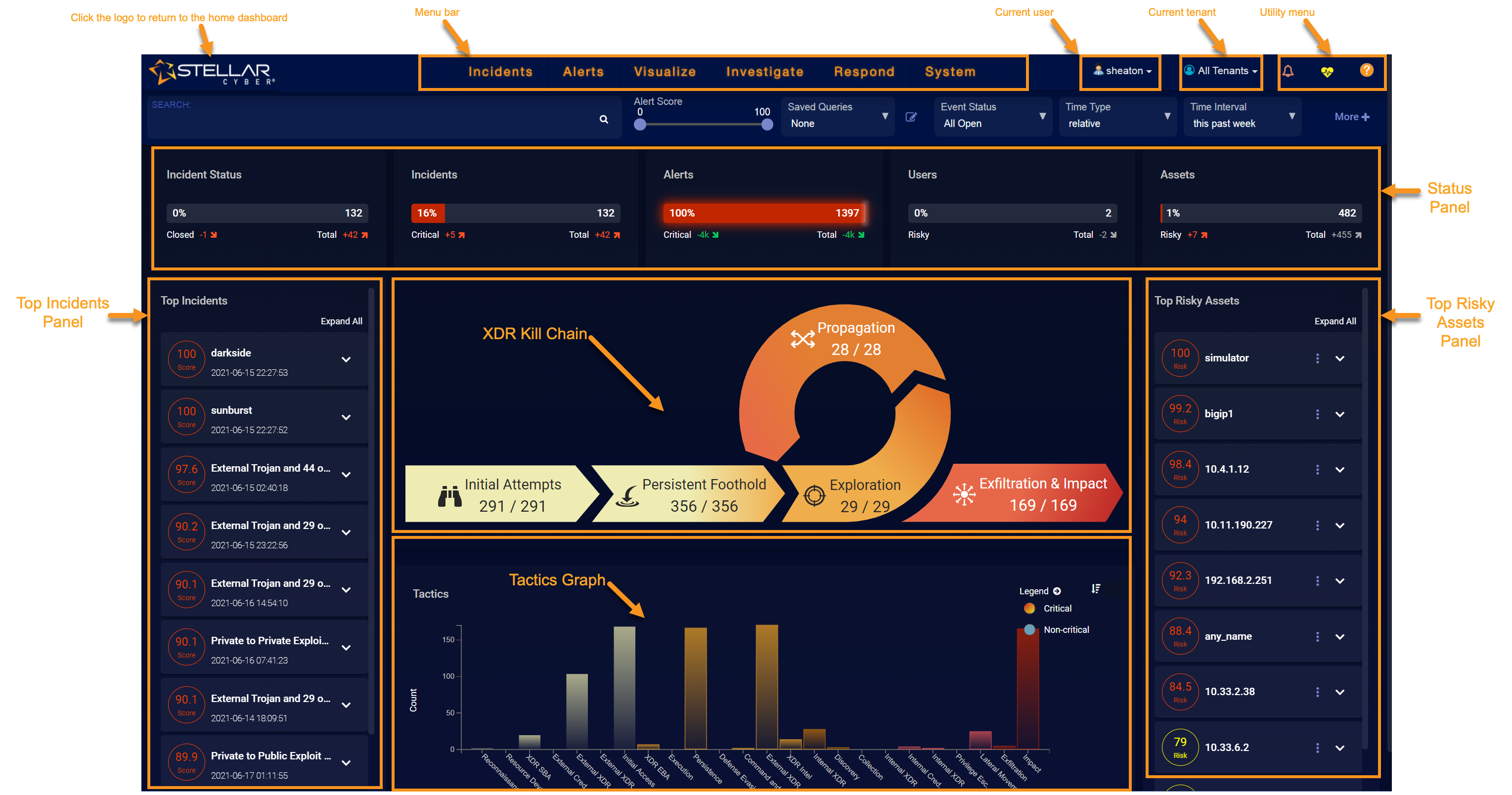Alert Scoring and Categories in Stellar Cyber
This topic describes scores assigned to alerts and definitions of the criticality of alerts.
Scores Assigned to Alerts
Scores are designed to help ranking and filtering alerts, understanding the significance and security value of alerts, and facilitating prioritization of alert triage.
There are different scores in the Stellar Cyber platform as follows:
-
Alert Score—A comprehensive level of risk and significance of an alert, reflecting aspects of security, confidence, and intelligence.
-
Severity—The security component of Alert Score, reflecting the security value in terms of security consequence and specificity.
-
Fidelity—The confidence component of Alert Score, reflecting the likelihood of an alert being a true positive.
-
Threat Intel—The intelligence component of Alert Score, reflecting the suspiciousness of IP addresses, domains, and URLs in an alert.
Alert Score, Fidelity, Severity, and Threat Intel scores are displayed throughout the Stellar Cyber user interface, particularly in Event Detail displays, as illustrated below in the Event Detail Header.
Alert Score
The Alert Score field in the Interflow data is event_score.
Alert Score has the following details:
-
It is computed from Severity (the security component), Fidelity (the confidence component), and Threat Intel (the intelligence component).
-
It reflects a comprehensive level of risk and significance of an alert from the three components.
-
It is designed for global ranking and filtering of alerts from all alert types, where alerts with higher scores are worth more attention and should be prioritized and investigated immediately.
Severity
The Severity field in the Interflow data is severity.
Severity has the following details:
-
It reflects the security consequence and specificity of an alert type or a Sigma rule that detects a certain type of attack, serving as the security component in Alert Score.
-
On representing the consequence, alerts in later Kill Chain stages generally get higher severity scores due to the significance of possible consequences, for example, stealing credentials (in a later Kill Chain stage) has a higher severity score than scanning behavior.
-
On representing the specificity, alerts that carry more specific security information generally get higher severity scores, for example, alerts on a known Command & Control IP address would get a higher severity score than those on an unspecific suspicious IP address. For example, the Command & Control Reputation Anomaly has a severity of 70, whereas the Bad Source Reputation Anomaly has a severity of 30.
-
An alert with a high severity score indicates that it would either cause severe impact and/or carry very specific security meanings.
Severity is documented for all built-in and rule-based alert types. Refer to Machine Learning Alert Type Details and Rule-Based Alert Types.
Fidelity
The Fidelity field in the Interflow data is fidelity.
Fidelity has the following details:
-
It reflects the confidence of an alert being a true positive, serving as the confidence component in the Alert Score.
-
Non-ML based alerts have a fixed Fidelity, and ML based alerts have a variable Fidelity computed by the ML model to reflect the model’s confidence.
-
Fidelity is useful in ranking and filtering alerts from the same alert type with the same Severity for prioritization. Alerts with high fidelity scores should be prioritized as they are more likely to be true positives.
For details on ML models, see Machine Learning Model Summary.
Threat Intel
The Threat Intel field in the Interflow data is threat_score.
Threat Intel has the following details:
-
It reflects the reputation of the IP addresses and URLs as assessed by the threat intel sources. The higher the Threat Intel Score, the worse the reputation.
-
If Threat Intel is high, it drives the Alert Score higher. If Threat Intel and Fidelity are low, it drives the Alert Score lower.
Alert Criticality Definitions
This section describes the definition of the criticality of alerts for Alert Score and Fidelity categories.
Alert Score Categories
Stellar Cyber uses a consistent set of categories throughout the user interface to group alerts based on their Alert Score:
|
Alert Severity in Stellar Cyber |
Best Practices for Monitoring and Investigation |
Alert Score |
|---|---|---|
| Critical |
Alerts of high severity and fidelity that must be investigated immediately |
Alert Score ≥ 75 |
| Major |
Alerts that are likely to be true positives or that could have significant security consequences and should be given priority to investigate |
Alert Score ≥ 50 and < 75 |
| Minor |
Alerts of lesser severity and/or fidelity that should be investigated if time permits; or otherwise be investigated together with correlated alerts in cases |
Alert Score ≥ 25 and < 50 |
| Notice |
Alerts of weak abnormal signals that are likely false positives or of less security concern, and may be investigated together with related alerts and events, such as alerts in the same cases and relevant events identified in threat hunting |
Alert Score < 25 |
Additional details:
-
The Alert Score range varies by alert type. Alerts from earlier Kill Chain stages may not ever reach the Critical level, but it does not mean that they are not security significant.
-
For certain alert types and/or attacks of interest, depending on individual SOC practices, we recommend a mixed strategy of using both Alert Score Categories and Fidelity Categories to further help the prioritization of investigation effort.
Alert categories are displayed throughout the Stellar Cyber user interface, particularly in the XDR Kill Chain dashboard and loop, as illustrated below:
Fidelity Categories
Stellar Cyber categorizes Fidelity Scores consistently throughout the user interface as follows:
|
Fidelity Level in Stellar Cyber |
Fidelity Score |
|---|---|
| High Fidelity | Fidelity Score ≥ 75 |
| Other Fidelity | Fidelity Score < 75 |
Additional details:
-
High Fidelity alerts are those likely to be true positives. They are reported either by rules that are specific to certain attack signals, or by ML models with high confidence.
-
Monitoring and investigating High Fidelity alerts, despite their Severity, is highly recommended for certain alert types of interest. For example, to catch account takeover attacks, which may cause significant security impact if not contained promptly, the SOC team may specifically prioritize the investigation of High Fidelity alerts of Impossible Travel Anomaly and User Login Location Anomaly.
Fidelity categories are displayed throughout the Stellar Cyber user interface, particularly in the Alerts page and its associated tables and graphs. For example, you can see the High Fidelity column in the Alerts display below indicating the quantity of alerts for the corresponding Alert Type with a Fidelity Score of 75 or greater.



